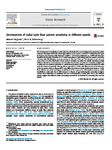Development of radial optic flow pattern sensitivity at different speeds
| dc.contributor.author | Joshi, Mahesh Raj | |
| dc.contributor.author | Falkenberg, HK | |
| dc.date.accessioned | 2020-09-15T08:42:50Z | |
| dc.date.available | 2020-09-15T08:42:50Z | |
| dc.date.issued | 2015-05 | |
| dc.identifier.issn | 0042-6989 | |
| dc.identifier.issn | 1878-5646 | |
| dc.identifier.uri | http://hdl.handle.net/10026.1/16298 | |
| dc.description.abstract |
The development of sensitivity to radial optic flow discrimination was investigated by measuring motion coherence thresholds (MCTs) in school-aged children at two speeds. A total of 119 child observers aged 6-16years and 24 young adult observers (23.66+/-2.74years) participated. In a 2AFC task observers identified the direction of motion of a 5° radial (expanding vs. contracting) optic flow pattern containing 100 dots with 75% Michelson contrast moving at 1.6°/s and 5.5°/s and. The direction of each dot was drawn from a Gaussian distribution whose standard deviation was either low (similar directions) or high (different directions). Adult observers also identified the direction of motion for translational (rightward vs. leftward) and rotational (clockwise vs. anticlockwise) patterns. Motion coherence thresholds to radial optic flow improved gradually with age (linear regression, p<0.05), with different rates of development at the two speeds. Even at 16years MCTs were higher than that for adults (independent t-tests, p<0.05). Both children and adults had higher sensitivity at 5.5°/s compared to 1.6°/s (paired t-tests, p<0.05). Sensitivity to radial optic flow is still immature at 16years of age, indicating late maturation of higher cortical areas. Differences in sensitivity and rate of development of radial optic flow at the different speeds, suggest that different motion processing mechanisms are involved in processing slow and fast speeds. | |
| dc.format.extent | 68-75 | |
| dc.format.medium | Print-Electronic | |
| dc.language | en | |
| dc.language.iso | en | |
| dc.publisher | Elsevier BV | |
| dc.subject | Motion perception | |
| dc.subject | Radial optic flow | |
| dc.subject | Development | |
| dc.subject | Maturation | |
| dc.subject | Speed | |
| dc.title | Development of radial optic flow pattern sensitivity at different speeds | |
| dc.type | journal-article | |
| dc.type | Journal Article | |
| plymouth.author-url | https://www.webofscience.com/api/gateway?GWVersion=2&SrcApp=PARTNER_APP&SrcAuth=LinksAMR&KeyUT=WOS:000354149100008&DestLinkType=FullRecord&DestApp=ALL_WOS&UsrCustomerID=11bb513d99f797142bcfeffcc58ea008 | |
| plymouth.issue | 0 | |
| plymouth.volume | 110 | |
| plymouth.publication-status | Published | |
| plymouth.journal | Vision Research | |
| dc.identifier.doi | 10.1016/j.visres.2015.03.006 | |
| plymouth.organisational-group | /Plymouth | |
| plymouth.organisational-group | /Plymouth/Faculty of Health | |
| plymouth.organisational-group | /Plymouth/Faculty of Health/School of Health Professions | |
| plymouth.organisational-group | /Plymouth/REF 2021 Researchers by UoA | |
| plymouth.organisational-group | /Plymouth/REF 2021 Researchers by UoA/UoA03 Allied Health Professions, Dentistry, Nursing and Pharmacy | |
| plymouth.organisational-group | /Plymouth/Users by role | |
| plymouth.organisational-group | /Plymouth/Users by role/Academics | |
| dc.publisher.place | England | |
| dcterms.dateAccepted | 2015-03-06 | |
| dc.identifier.eissn | 1878-5646 | |
| dc.rights.embargoperiod | Not known | |
| rioxxterms.versionofrecord | 10.1016/j.visres.2015.03.006 | |
| rioxxterms.licenseref.uri | http://www.rioxx.net/licenses/all-rights-reserved | |
| rioxxterms.licenseref.startdate | 2015-05 | |
| rioxxterms.type | Journal Article/Review |


